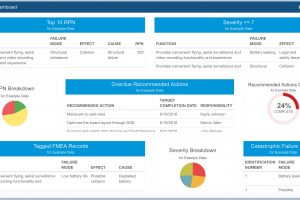Reliability and quality engineers rely daily on a variety of tools to perform their analysis tasks. Selecting which tools to use is a key decision and involves many factors. It is important that the decision is made with care because the tools that are selected will have an impact throughout the organization. Not only do the analysis tools impact the ability of team members to capably perform their work, they also directly impact the capability to meet reliability and quality objectives.
When deciding on a reliability tool or tool suite to employ, many times the choice between a commercially available software package and a custom-built solution arises. The focus of this article is to explain the benefits of selecting a COTS reliability software toolset.
What is COTS Software?
COTS is an acronym for commercial off-the-shelf. In reference to software, COTS refers to a packaged solution available from a third-party vendor designed for a specific purpose. COTS is an alternative to custom developed, homegrown, or one-off software solutions.

Why Should I Consider a COTS Tool?
COTS tools in general, and particularly for reliability analysis, can prove to be an excellent investment when you consider the many advantages they can offer. From providing ways to preserve valuable knowledge to allowing more time to focus on your core business objectives, COTS tools are often the ideal solution. Though not designed and developed to custom specifications, COTS tools are often determined to be the most beneficial choice when all factors are taken into consideration.
This article delves into some of the most significant advantages to consider when weighing the decision to purchase a COTS reliability analysis toolset. Most of the benefits detailed below apply to COTS tools in general, however, some specifically pertain to reliability analysis tools. Additionally, the examples used to illustrate concepts use reliability analysis terms and principles.
#1: Knowledge Preservation
One critical issue that confronts all businesses is capturing and retaining domain knowledge as team members change. When facing the decision to choose a custom solution over a COTS tool, this knowledge loss is two-fold.
First, oftentimes there are “experts” on the team who retain vast knowledge due to their experience and expertise. If those team members leave, that knowledge goes with them. However, when you successfully implement a capable, enterprise COTS tool, that vital information is stored and maintained in a database. Other team members can more capably pick up and continue working without having to relearn and uncover information that is no longer easily accessible after personnel changes.
Secondly, in most cases, when a COTS tool is not used, there is a person or small team who is responsible for maintaining the tools used to perform reliability analyses. In some cases, this is a homegrown tool. In other cases, it may be adapted or customized versions of generic tools such as Microsoft Excel or Google Sheets. If the expert on this set up leaves, you have the same issue as outlined above – that knowledge is lost. This becomes a common reason we hear for turning to a COTS tool: the team member who set up the homegrown platform for reliability analysis work is no longer there and now the team is struggling.

#2: Quick Start Up
Selecting a COTS tool enables you to make a decision one day and be up and running the next. Otherwise, you will be faced with the requirement to build your own solution. There are several disadvantages to this approach. Surprisingly, one often overlooked is lost time.
There are ways to minimize the amount of time involved in building your own toolset, such as paying a software solution provider to develop the tool. However, you need to design and specify the requirements for your custom software and oftentimes, the level of effort needed for this process is sorely underestimated. Also, there is the need for revisions or modifications during development or after delivery. Even with the most detailed of specifications, revisions to the software are inevitable.
By taking advantage of the quick start up available when implementing a COTS solution your team can immediately begin moving ahead on projects and realizing all the additional benefits COTS tools provide.
#3: Compliance
For compliance related projects, the COTS tools’ ability to meet the appropriate requirements is a key advantage. For example, many clients have a need to perform MTBF analysis on a specific standard such as MIL-HDBK-217. In this case, a COTS tool delivers this support out-of-the-box. No one needs to reinvent the wheel by delving into the details of the MIL-HDBK-217 standard and developing a tool to support it.
Plus, COTS tools providers have benchmarks in place to test and ensure that the results are accurate. The level of detail across standards such as those used in Reliability Prediction analyses makes formal testing essential. Reliability software providers have done this testing and offer products that reliably produce accurate results.
#4: Continual Updates
Reliability solution providers are also continually updating their products. This is a challenging effort for any in-house, custom solution to meet.
There are multiple reasons that updates are an ongoing effort for reliability analysis tools:
- A constant issue that must be addressed is updates to other software, such as the OS (Operating System). We are all familiar with apps or software packages that no longer work with OS updates!
- Updates to compliance-based standards must be maintained. Standards can be revised at any time. To keep compliant, your software tools must be updated when revisions occur.
- Updates to software design, such as the user interface, are critical for quality software tools. It is easy for users to identify “old” software, and it is frustrating to use. For custom solutions, this is an ongoing problem. It is difficult to make a decision to pay to update software for “usability” reasons. However, without it, your software becomes harder and harder to use and will eventually run the risk of being abandoned.
One of the main goals of reliability software tool providers is to keep their software products up to date. This means keeping up with the latest technological advancements, the latest developments in the reliability engineering field, and the latest in usability trends.

#5 Standardization
A significant advantage of COTS tools is the ability to control and standardize your processes and procedures across your organization. This means everyone is using the same tools, so everyone is speaking the same language and using the same interface. Team communication is much more efficient when everyone is on the same platform. Also, if team members move to a new job function within your organization there is no need to learn a new tool.
Most importantly, reliability software tools provide a structured approach where all team members are using the same formats and methods for their analyses. For example, with reliability software such as Relyence, you can create a customized FMEA Worksheet to use as a template. This ensures that all your FMEAs follow the same process and new FMEAs have a standard to use right from the start.
#6: Extra Features
When first looking at COTS tools for reliability analysis, most customers initially are looking for very specific features:
- Support for the standards needed for regulatory or internal requirements
- Data reports that include the necessary data
- Accurate results
Clearly, these are the most basic and important features that must be available before a COTS tool can be considered. However, once assured that these essential features are met, most customers then learn of the breadth of additional capabilities that make a COTS tool much more advantageous. The benefits of these extra features become quickly apparent: your analyses are easier to perform and more efficient, allowing you undeniable savings in terms of time and money.
Just a few of the long list of extra features in the Relyence platform include:
- What-If? trade study analysis
- Dashboards for high-level overviews
- Libraries for data storage and easy retrieval
- Importing and exporting capabilities for transferring data
- Intuitive user interfaces for ease-of-use and understanding
- Powerful features such as the Knowledge BankTM for knowledge capture and reusability
- Data integration features such as Failure Direct ConnectTM
- Automation capabilities such as FMEA Data AutoflowTM
- Workflow, Approvals, and Notifications for process control and team communication
- User and group roles and permissions for management and control
#7: Cross-Analysis Integration
There are an array of reliability analysis tools and techniques used by engineers. Some of the tools in the reliability analysis arena include:
- FMEA (Failure Mode and Effects Analysis) and FMECA (Failure Mode, Effects, and Criticality Analysis)
- FRACAS (Failure Reporting, Analysis, and Corrective Action System)
- FTA (Fault Tree Analysis)
- Reliability Prediction
- RBD (Reliability Block Diagram)
- Maintainability Prediction
- Weibull Analysis
- ALT (Accelerated Life Testing) Analysis
- RCM (Reliability Centered Maintenance)
While in some cases, the complete list of tools/techniques are used, typically analysts use a subset of this list. When more than one tool is used for analysis, there are several notable advantages a COTS solution provides.
The Benefits of Cross-Analysis Integration
Cohesive Platform
First, COTS reliability tools offer a cohesive platform for performing analyses. For example, you may choose one tool, such as Excel, for performing FMEA, and pair that with a vendor tool for Reliability Prediction. In this situation, sharing data between your analysis tools requires importing and exporting to/from each other. COTS tool sets provide the ability to store and share data across your analyses more easily. For example, failure rates provided in Relyence Reliability Prediction can be automatically shared with Relyence FMEA, Relyence RBD, and Relyence Fault Tree. Also, in Relyence, your product breakdown or structure can be defined in one place and then is automatically available across all analysis tools in our suite.
Guaranteed Up-to-Date Data
Secondly, data sharing across COTS tools ensures that the data in use is always up to date. This is a continual headache when multiple tools are in use. Using the example above, when using a common platform, if a team member updates a Reliability Prediction analysis and failure rates change, this update automatically ripples through to other analyses such as FMEA using that information. If you are using separate tools, you know that issues arise when a team member makes a change that updates failure rates in Reliability Prediction. In one case, the FMEA team member relying on these values may not be notified of the update and continues to use stale data. Or, in another scenario, the FMEA team member is notified, but then somehow needs to update all his failure rate values. In either case, it’s not a good situation! An integrated COTS tool eliminates this problem.
Common User Interface
Additionally, COTS reliability tools offer a common user interface. This means that moving between analysis tools does not involve changing gears or learning new practices. Your analysis tools share a similar “look and feel” and it makes it easier for team members to come up to speed as needed.

#8: Future Growth
When looking at the list of tools offered from a COTS vendor, oftentimes you do not think you will ever need all available capabilities. And, initially, this may be the case. However, it is very common for organizations who are using one analysis technique to determine sometime down the road that they can benefit from another. In some cases, teams simply don’t do particular analyses because they don’t have the tools to easily perform the tasks.
COTS tools offer a substantial benefit for supporting future analysis needs as your company grows and evolves. By offering many types of analysis tools in an integrated package, COTS tools allow you to easily expand your reliability analysis toolset when required.
#9: Extensibility & Integration
Reliability analysis tools are often part of a large set of software tools in use as part of an organization’s processes and procedures for product design, development, manufacture, and delivery. COTS tools are designed with this in mind and offer integration points, data exporting capabilities, and more. The integration of your reliability analysis tools can be as loose or tight as you prefer. For example, Relyence supports an easy step-by-step guided process to export data for use in other reports or tools. Relyence also provides a rich API (Application Programming Interface) for those who want to tightly integrate reliability tools into a broader platform.
#10: Core Competency
As a last consideration, it is helpful to think about the value a COTS tool offers by allowing you to concentrate your time and effort on what you know best: your business. You do not need to expend effort to create, maintain, and update homegrown tools. Instead, your team members are working on the tasks most essential to your business success.
It also means that you are relying on those whose core competencies include reliability engineering and software development for your reliability software tool set. By using a team whose focus is keeping abreast of the latest developments in the reliability field as well as developing the best-in-class tools available for reliability analysis, you can rest assured that your reliability analysis needs are well taken care of.
In other words, let us spend our time doing what we do best so that you spend your time doing what you do best!

Cost Analysis
Compared to building a home-grown tool or contracting out to a software solution provider for custom software, the cost to implement a COTS solution is significantly lower. You do not incur the cost of time spent by your team designing and specifying your custom requirements, or the development costs of creating the tool – whether done by an outside service firm or your own in-house staff. In addition, because COTS tools remain up to date, further investments in terms of time and money to upgrade your custom solution are not required. Not only is the COTS solution financially advantageous, but you also gain all the benefits outlined in this article. It’s the reason COTS tools are a winning strategy for so many businesses.
As with any business decision, it is wise to do a cost-benefit analysis. Because each case is unique, we cannot determine which factors are most critical for you or effectively determine the associated cost savings for your situation. However, you can do so by weighing the issues that are most important for your organization and evaluating the costs savings realized.
When all factors are taken into consideration, implementing a COTS software is most often the most cost-effective solution. At Relyence, we know from experience that an investment in a COTS reliability tool suite will pay off quickly.
Relyence Reliability Software: A COTS Solution with Customization Capabilities
Relyence is a COTS solution for reliability analysis offering a full suite of tools. It is important to keep the following in mind when evaluating Relyence:
- While Relyence is not a custom designed platform, it is extensively customizable. We recognize there is not a one-size-fits all approach to reliability software tools, so we design and build our products to meet the demands of many different customers across a wide range of industries. Customization options are available to you directly, or our services team can help tailor our solution to your needs.
- Our best suggestions for improvements and product enhancements often come from our customers! If you don’t see something in our products that you need or desire, just ask! We love to incorporate ideas based on what you require and what will make your job easier.
- Relyence offers full services, not just software solutions. We can provide software training, consulting, and implementation services to get you and your team up and running smoothly and efficiently.
Give Relyence a Test Run!
Relyence offers a best-in-class COTS tool suite for all your reliability analysis needs. It incorporates all the benefits outlined here and more. We also offer a hassle-free, no-download, free trial. Feel free to contact us today to discuss your needs or schedule a personal webinar.





